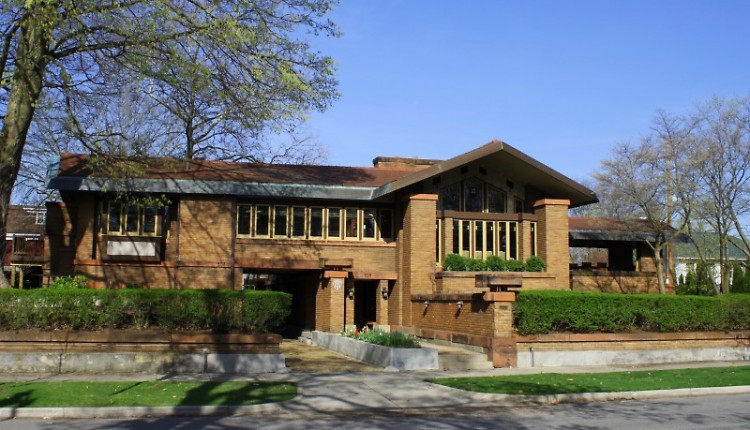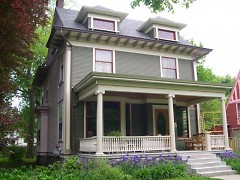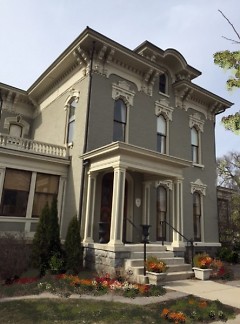A grandfather clock, an engraved gold watch, great grandmother’s patchwork quilt, a fine mahogany table where generations of a family have shared dinners and dreams- heirlooms that have been lovingly passed down from one generation to another. Family treasures are precious whether as grand as a piano or as small as a baby’s silver spoon. They connect our past to the present, preserve our history, tell our stories.
The homes in Heritage Hill are the heirlooms of the Grand Rapids family. Some are magnificent reminders of our Furniture City past. Some are more modest, but no less significant to the history of our neighborhood. The homes on Tour this year are varied in architectural style, dimension and grandeur, but each one has a unique and fascinating story. All of our hosts have come to love their homes and realize that these treasures have been passed down to them for safe-keeping and for sharing with the next generation. They invite you in for a tour and a tale.
The Line-up:
71 LAFAYETTE N.E.
This 1874 Italianate treasure is the definition of perfection. The elegance of the detailed brick facade continues in the interior. From the grand front doors to the sweeping stairway, from the ornate woodwork to the tall windows that are almost as high as the 11’ ceilings, the meticulously restored interior of this home takes you back to the time of calling cards and 4 o’clock afternoon tea. Since a major renovation by William and Anna McKnight in the early 1900’s, this home has remained fundamentally unchanged for over a century. The Connors spent an entire year restoring the home, repairing the inevitable effects of almost a century and a half of daily use. All of the mechanical systems have been updated. Recently, they have created an amazing kitchen with top-of-the-line everything, including a custom copper range hood with inset copper tiles to match and a wood-faced refrigerator that matches the cupboards. Among the many distinctive rooms in this home, the sunlit stair landing competes with an inviting sunporch as the ultimate cozy spot to curl up in for a good read. These are just a few of the distinctive features of this picture-perfect home.
505 COLLEGE S.E.
Entering the Amberg House is like walking through a work of art. Designed by Marion Mahoney, a protégé of Frank Lloyd Wright, this Prairie Style home has all the characteristics of a style that attempted to make a building blend with its surroundings. The emphasis is on a horizontal look and feel, with small spaces that lead to light and open rooms and stained-glass in the windows and overhead lighting that reflect the colors of nature. Views from the many windows and a large veranda blend the outdoors with the in. The current owners have spent the last few years on major renovations. They have incorporated one of the apartments back into the main house, have added a 1/2 bath and, with the removal of a wall and a complete remodel, have opened up the kitchen and created a fabulous work space for Deb and Scott who love to entertain. Deb has found a perfect place for each of the many works of art that grace the home. Though the style of the architecture is somewhat formal, the furnishings and personal touches make this home warm and welcoming. The colorful gardens with a koi pond, sculptures and new perennial beds, add the finishing “Monet” touch to this masterpiece.
521 MADISON S.E.
The quaint details of the facade- floral cutouts, a variety of window shapes, bay widows, a charming little dormer and a recently restored wrap-around porch give this home grace and character. Henry Baker and his wife built this Queen Anne in 1886 and Ellen remained in the home until her death at age 101 and beyond… Flickering lights, footsteps and occasional appearances have made Sue and Dave realize that Mrs. Baker loved the house so much that she just couldn’t leave! It is easy to see why. This home is uniquely designed so that all of the first floor rooms come off of the entry hallway like spokes of a wheel and the wide pocket doors give an encompassing view of the whole downstairs including a library, a living room with a beautiful mantle and a stained-glass bay window and a dining room with another huge bay. The woodwork is the star of the show. Upstairs, there is an office that extends into the attic, a master bedroom with its own fireplace and a child’s room where Mrs. Baker was once heard singing a lullaby to the baby. Family heirlooms are found throughout. A “spirited” tour through this home is guaranteed.
264 PARIS S.E.
The owners barely knew what was hiding beneath the jungle when they bought this home in 1975. Once the vines and shrubs were removed and the home painstakingly restored, a lovely Victorian Gothic cottage was revealed. The wrap-around porch and unique oak front door welcome you to a home filled with antiques, many with ties to family and friends. All the fun nooks, bay windows and unusual rooms provide the perfect backdrop for a square piano, an antique love seat, a charming china cabinet, a hand-made cedar chest that goes back three generations and much, much more. The most unusual room is a smoking room/den on the second floor that was redone in 1918. With a fireplace, rough beams and rustic hardware, it looks more like a medieval enclave than a dignified Victorian room. The dining room is more traditional, with oak woodwork, textured stucco wainscoting, a lovely bay, a stately fireplace and rich, floral English wallpaper. This home and its treasures have a wealth of stories to share.
417 CRESCENT N.E.
The gingerbread facade of this Stick Style home could not be more charming, with sunbursts, floral cut-outs and decorative trim on every peak. Looking at it now, it’s hard to believe that it was once an unsightly disaster, boarded up and scheduled for demolition. George and Maree Beckon adopted this abandoned orphan in 1986 and transformed it into a two-family wunderkind. The gas/ electric chandeliers and sconces, ornate brass hardware, and plumbing fixtures that they brought from their former 1900’s house look right at home here. The clear pine woodwork is almost overwhelming, including a huge, unusually shaped pocket door, stately columns and many large windows. The owners have spent the last year updating the inner workings and freshening the place from ceiling to floor, preparing it for the next lucky renter. They have chosen furnishings, many in the Eastlake Style, from the era when the home was built. The tour will be of the downstairs apartment where a Grecian woman with a lighted torch awaits you in the parlor.
544 COLLEGE S.E.
This 1907 Craftsman Style home is a perfect example of the Arts and Crafts emphasis on quality of workmanship and the importance of natural, time-honored materials. It begins with one of the most beautiful front porches in Heritage Hill and ends with a recently added deck in back that was built to match the architecture of the house. The owners have been true to the Arts and Crafts philosophy in all of their restoration and remodeling work. The foyer in this home is exquisite with glowing quarter-sawn oak used for the floors, doors and windows, the stairway and a welcoming bench. You can catch a glimpse of a tulip patterned stained-glass window on the landing, lit by a tooled metal antique light. The oak continues through the downstairs, with a bay window in every room and a coffered ceiling in the dining room. The deck creates an extra seasonal living space and the lovely surrounding gardens should be perfect for a peaceful stroll on the weekend of the tour.
422 FOUNTAIN N.E.
Built in 1903 by the well-known Widdicomb furniture family, this home has a surprise around every corner, starting with the very first corner as you enter the front door. The kitchen has been moved to the front of the house, and a wall was removed to create a kitchen/dining great room. Cupboards were built in the former front parlor to match the original cherry woodwork in the windows, trim and the eye-catching built-in hutch in the dining area. A central winding stairway makes quite a design statement as it takes you to the spectacular master suite, with a fireplace and custom built-in closets and dresser. The bath is elegantly modern in design. Throughout the home, modern light fixtures are works of art that accent every room. The colors and furnishings chosen for the house are fresh and current giving each room a distinct personality. The facade is as surprising as the interior with a massive front gable and a serendipitous mix of peaks, porches, windows and dormers.
Oakwood Manor – 547 Cherry SE
The apartments of Oakwood Manor have been home to some of the elite families of Grand Rapids and more than a few famous visitors, including Spencer Tracy. When it was built in 1923, Oakwood Manor was THE place to live. Its modern, fireproof, steel and cement inner structure was covered with brick and stone. At seven stories, it was the tallest building in the area, with panoramic views from the upper, balconied rooms. Every amenity could be accessed right in the building from fine dining to a grocery store and a deli, a doorman and a porter, a beauty salon and a barber shop, a newsstand and a cigar shop, maid service and a 24 hour switchboard and, amazingly, a fleet of Buick sedans for use by the tenants. Today, much of the original glamour remains. A lovely fountain graces the columned entrance that opens to a spacious, recently redecorated lobby. Currently, there are 96 apartments and 600 square feet of commercial space in the building with plans for a fitness center and a restaurant that will have some outdoor seating in the back courtyard. The lobby and one of the apartments will be on the tour.
CALKINS LAW OFFICE:
This gleaming white Greek Revival building, with its noble columns and stately symmetry, was built in 1836 and is the oldest surviving structure in the city. Originally located in the heart of a Grand Rapids when it was still just a frontier town, it stood as a symbol of the bright future that would be this city’s destiny. Charles Philo Calkins purchased the building in 1837 and set up a law office with his partner, John T. Holmes. The city was growing rapidly, and Calkins’ practice, dealing mostly with real estate law, prospered as well, and soon outgrew this tiny building. When streets needed to be widened downtown, the office was moved to the Belknap Park area, and over time it was forgotten and neglected. Eventually, it came under the care of the Public Museum. It was fully restored, and the dedication ceremony in its current location at the meeting point of State, Washington and Jefferson, was part of the Bicentennial celebration of 1976.
CHILD DISCOVERY CENTER / 409 LAFAYETTE S.E.
Grand Rapids Public Schools
When this school was built in 1922, it was considered to be the most beautiful school building not only in Grand Rapids, but in the entire state of Michigan. The Harvard-educated architect, Henry H. Turner, based his design on the philosophy that ”beauty should be part of a child’s heritage” and he created this Academic Art Deco Style structure with a keen sensitivity to how the environment would contribute to the comfort and aesthetic sensibilities of the children.
The Child Discovery Center for grades K-5, has fittingly found a home in a building that was originally dedicated to Senator Arthur H. Vandenberg, a man known for his commitment to improving relationships among the nations of the world. The program is based on the principles of the Reggio Emilia Approach that emphasizes development of critical thinking skills through rich and engaging experiences. Heritage Hill is very fortunate to have this impressive building and this innovative program in our neighborhood.
WOMEN’S CITY CLUB- 254 EAST FULTON
This 1856 Italianate Villa Style home was built by a former mayor of Grand Rapids, Martin Sweet. He was a very successful man in a variety of business pursuits ranging from grain to banking to lumber to the building of the Sweet’s Hotel that later became the Pantlind. Over the years it functioned as a music school and a boarding house. In 1924, it became the home of The Women’s City Club where, from its early beginnings until today, it has served as a forum for its diverse group of members. The architecture is striking with an ornately detailed facade. The home has an enclosed portico graced with a fanlight window, columns and carved paired brackets and dentils that are repeated in the broad eaves above. The entry is flanked by bay windows that are decorated with delicate arched tracery. The gentle curves are repeated in the ornate hooded windows and in the turret. The members welcome you to their history-filled home.
The Rapidian, a program of the 501(c)3 nonprofit Community Media Center, relies on the community’s support to help cover the cost of training reporters and publishing content.
We need your help.
If each of our readers and content creators who values this community platform help support its creation and maintenance, The Rapidian can continue to educate and facilitate a conversation around issues for years to come.
Please support The Rapidian and make a contribution today.



